Floral Design with Sunflowers and Zinnias
Designing with flowers is similar to learning how to play a musical instrument or draw a landscape. It takes time and practice to achieve the principles of floral design. Learning to design or be an artist on your own is possible, but training within a structured environment is more effective. Join and participate in garden clubs and floral classes, and consider becoming an MSU Extension Master Floral Designer. These activities provide the systemic practice and motivation to be a better designer tomorrow than you are today.
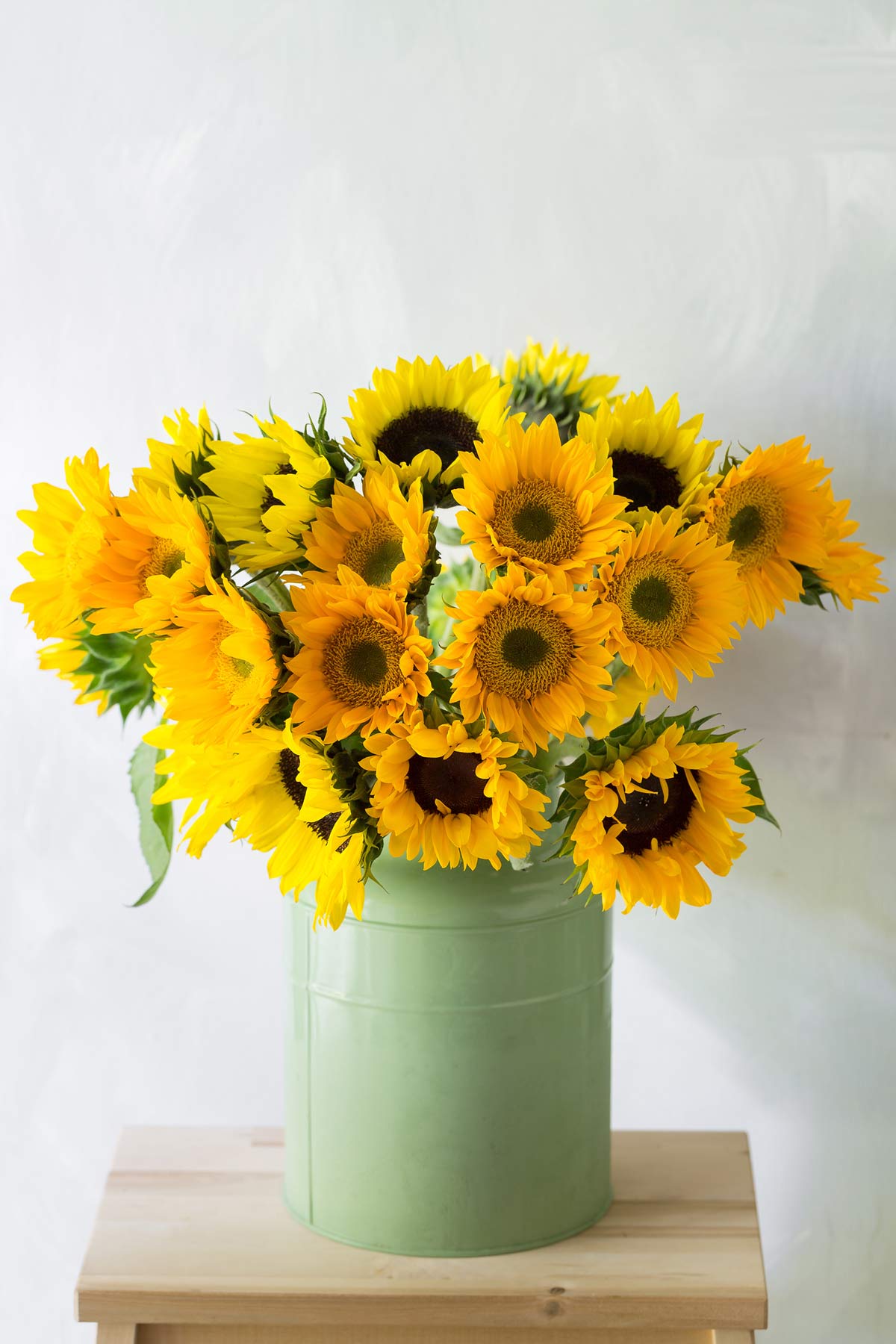
The best way to design with sunflowers is the Van Gogh way: simply cut the stems on an angle and drop them in a large, heavy container.
When designing with sunflowers, consider tall, upright vessels like pitchers and vases, as well as low-profile containers. Heavy-headed sunflower stems can be cut short and layered atop each other in a waterproof container. Add the flowers at the rim of the container first, then follow a spiral pattern toward the center. This allows you to use the flower for a table centerpiece. Another bonus of cutting the stems is that short-stemmed flowers often have a longer display life than long-stemmed flowers.
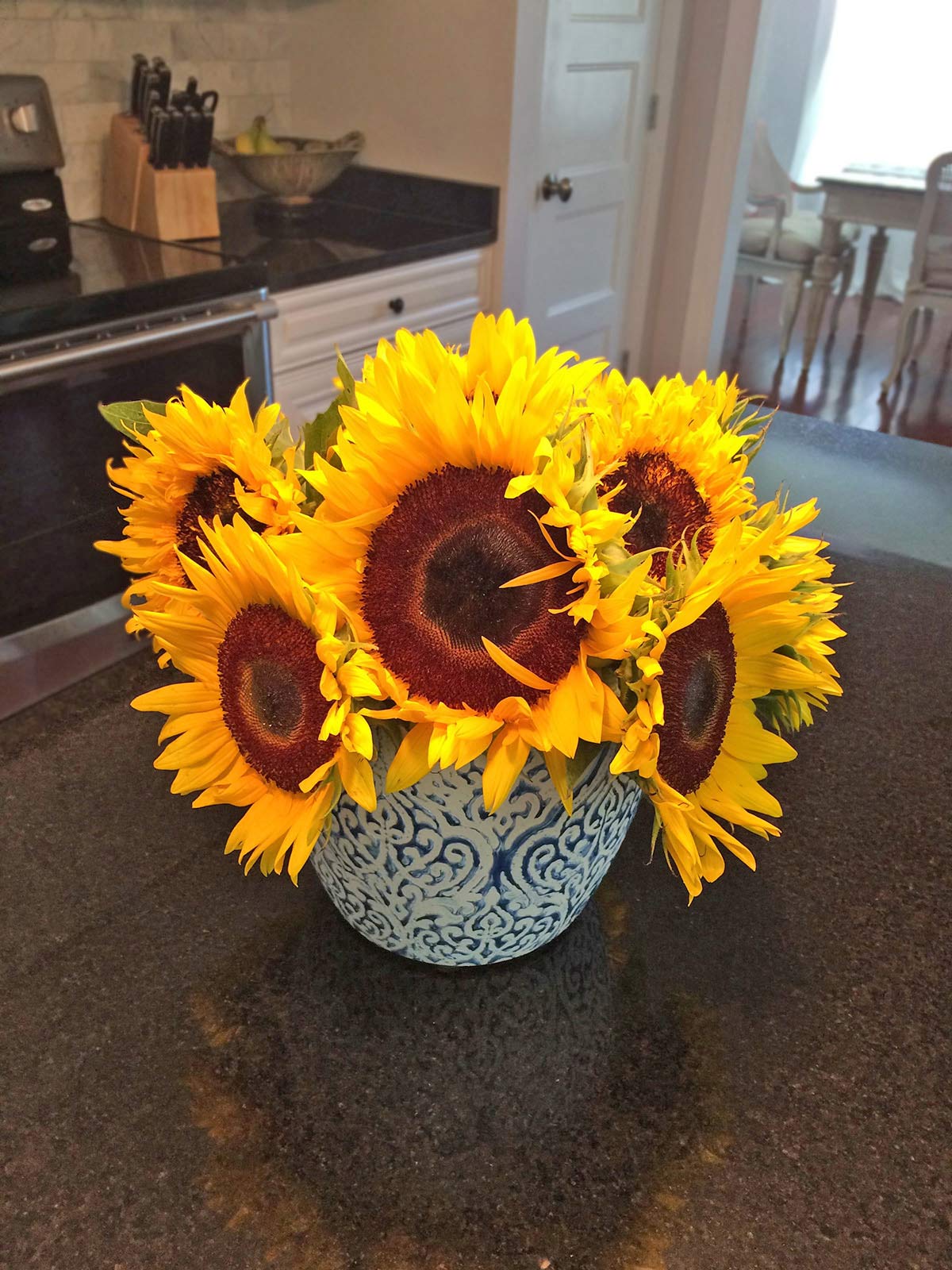
Sunflowers brighten any kitchen.
The 12-slice color wheel is a floral designer’s best friend. Note that colors lighten toward the center of the wheel (tints), become more gray toward the center (tones), and darken at the outer edge (shades). These are important aspects to consider when combining colors to make an arrangement.

Use the color wheel when creating floral designs. You can use monochromatic, analogous, or complementary color schemes.
Monochromatic
Monochromatic schemes use one color from the color wheel and any of its tints and/or tones and/or shades. This living room is designed in a monochromatic color scheme. A vase of blue irises would keep the scheme pure.
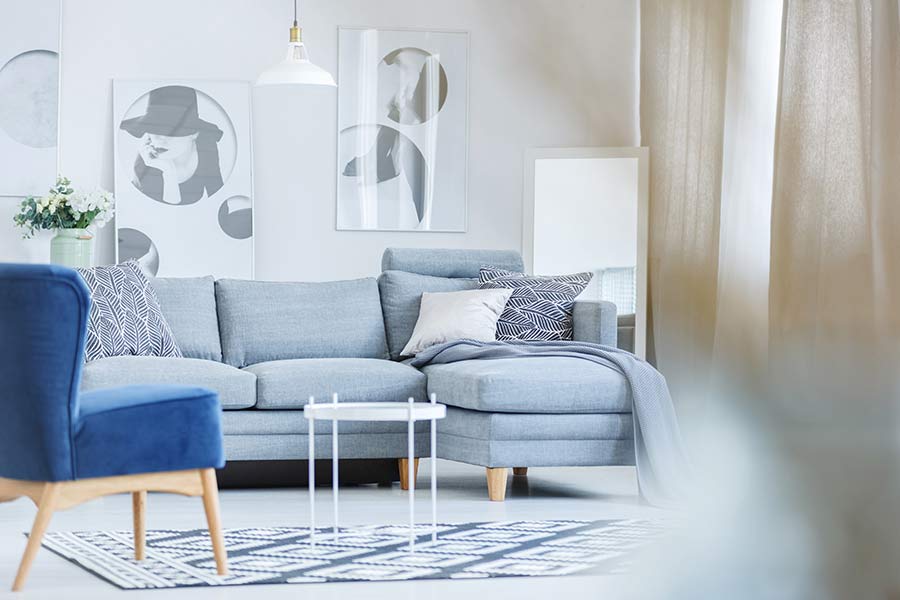
Analogous
Analogous schemes use two to four adjacent colors on the 12-slice color wheel. This example of dark violet, red-violet, and violet evokes a Dutch still life painting.
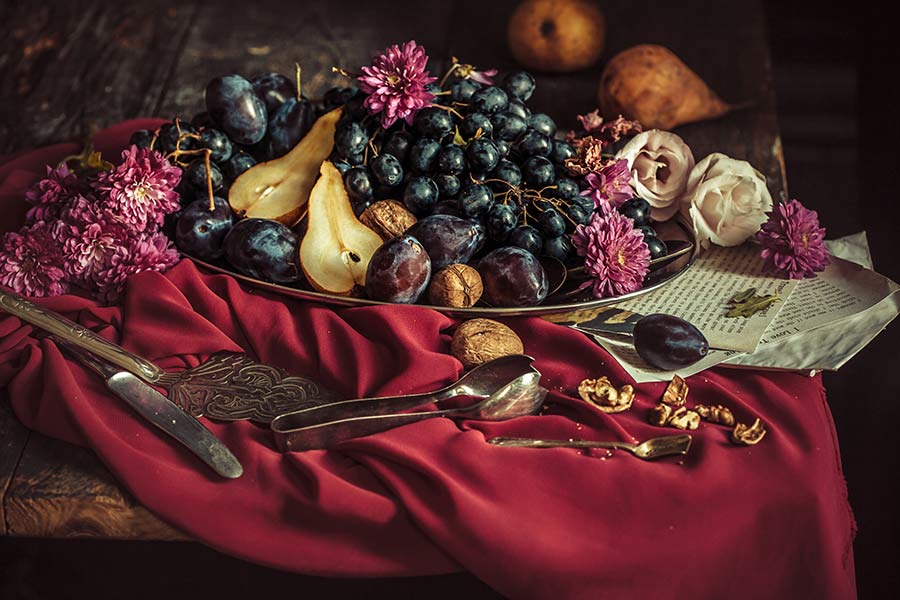
Complementary
Complementary color schemes use opposites on the color wheel. A coastal sunrise shows color-
opposites of orange and blue.

Zinnias and silver artemisia foliage look great in dim areas.
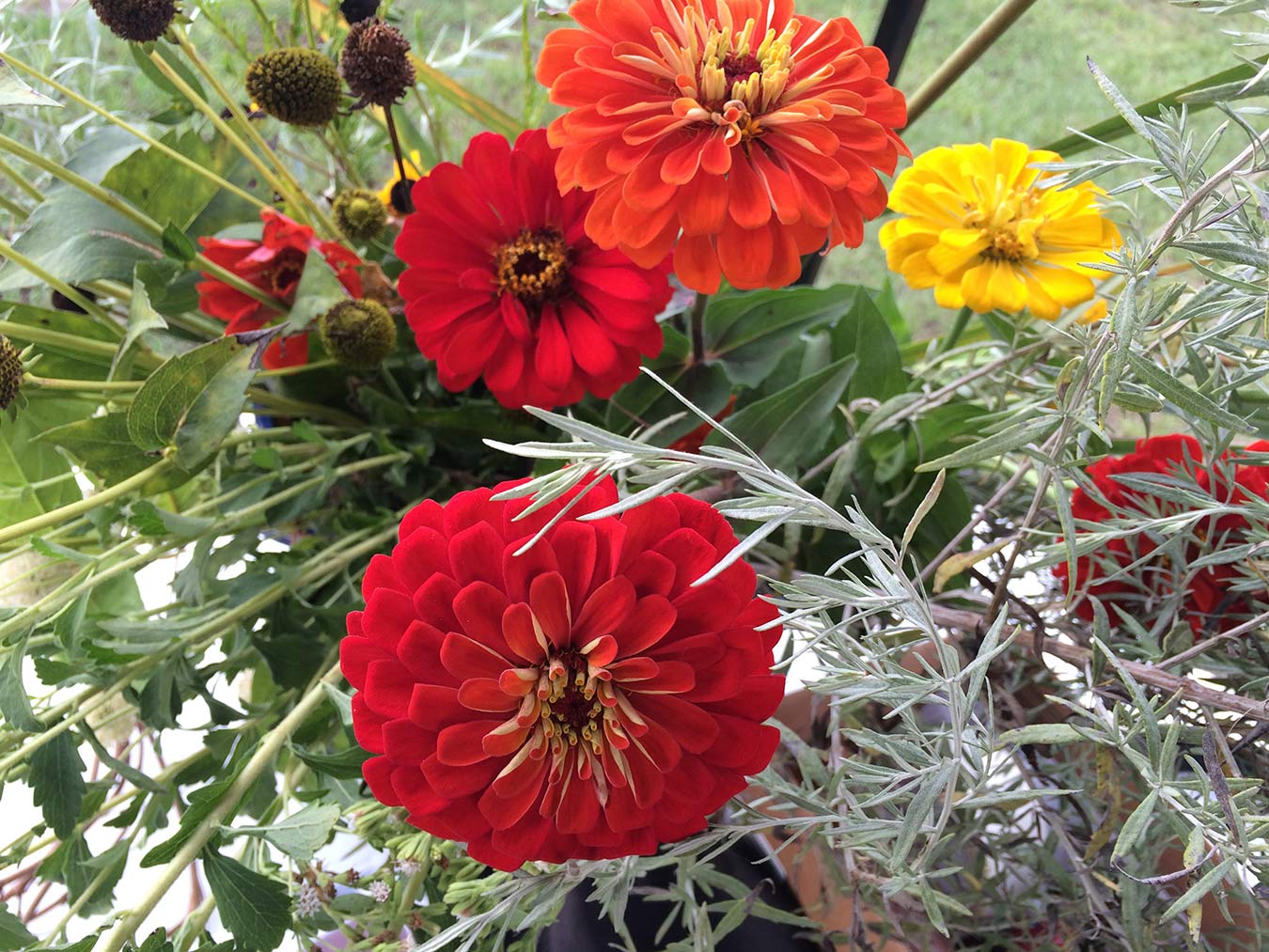
Before making an arrangement, consider the amount of light that will reflect on the finished display. In dim areas, use lighter colors (tints) and advancing colors like yellows, reds, and oranges. When lighting levels are bright, the blues, violets, and deep greens can be more easily seen and appreciated.
Design tip:
No matter what color combination you use, allow one color to dominate within a design.
When preparing fresh floral foam, never force the foam below the water line. Simply drop it on the surface of the water and allow it to freely float until fully hydrated. This process only takes about half a minute!
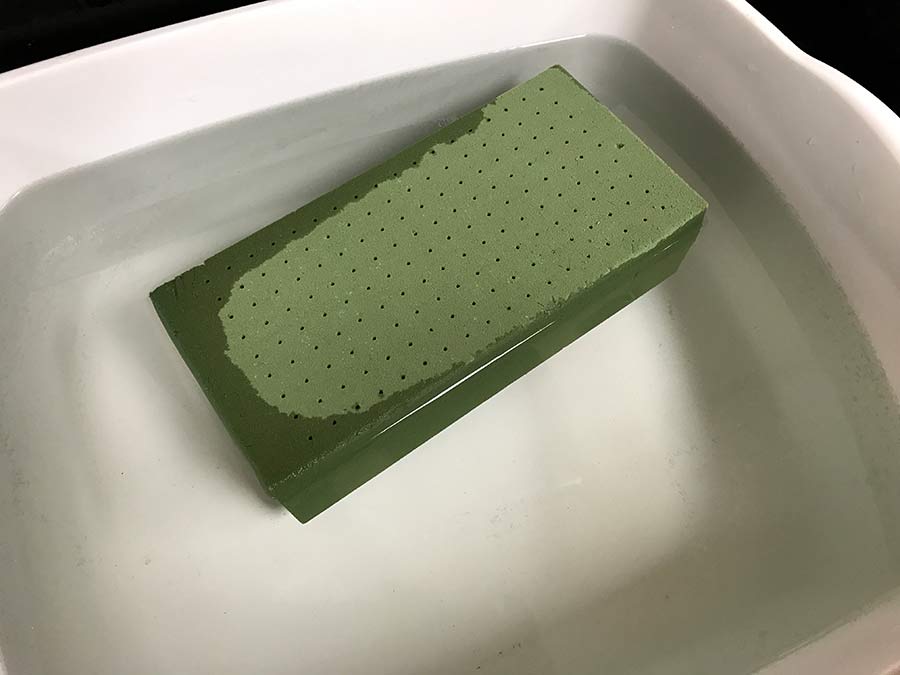
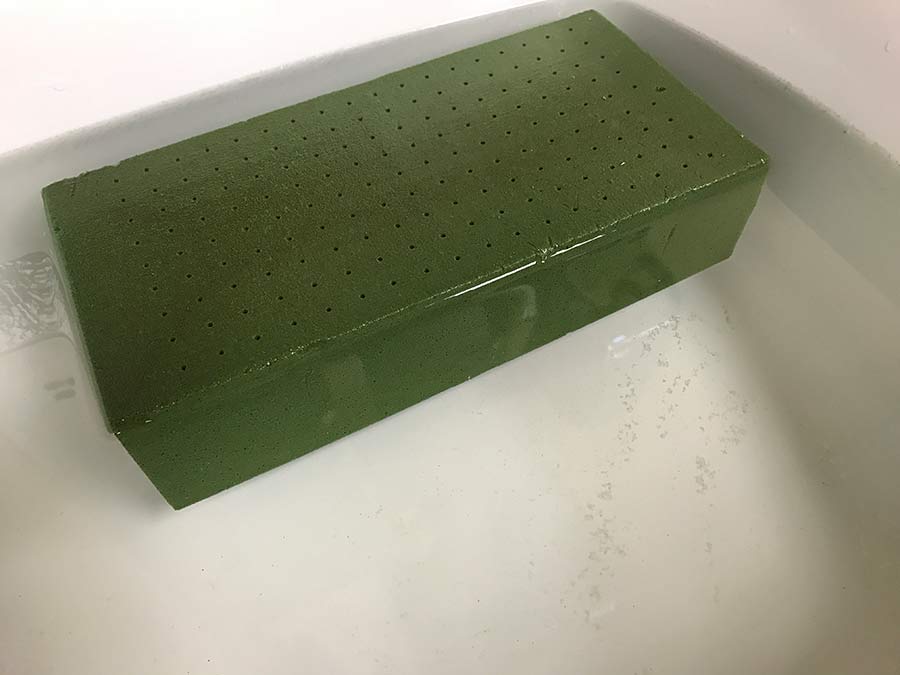
Floral foam hydration
This zinnia and sunflower arrangement with tall, white tuberose is an example of the design style called parallel systems. The stems are arranged in floral foam bricks in a waterproof container and perched on a box.
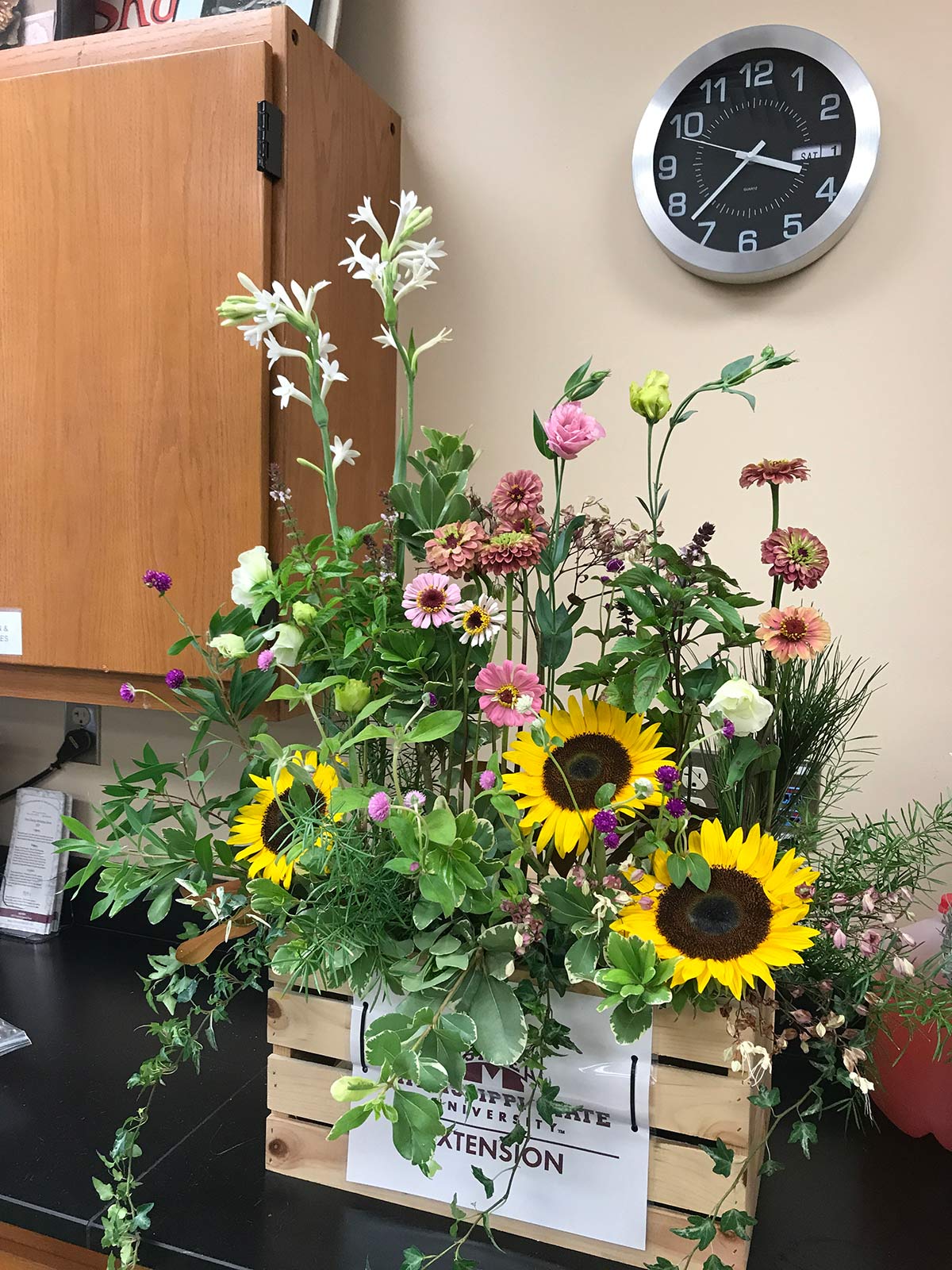
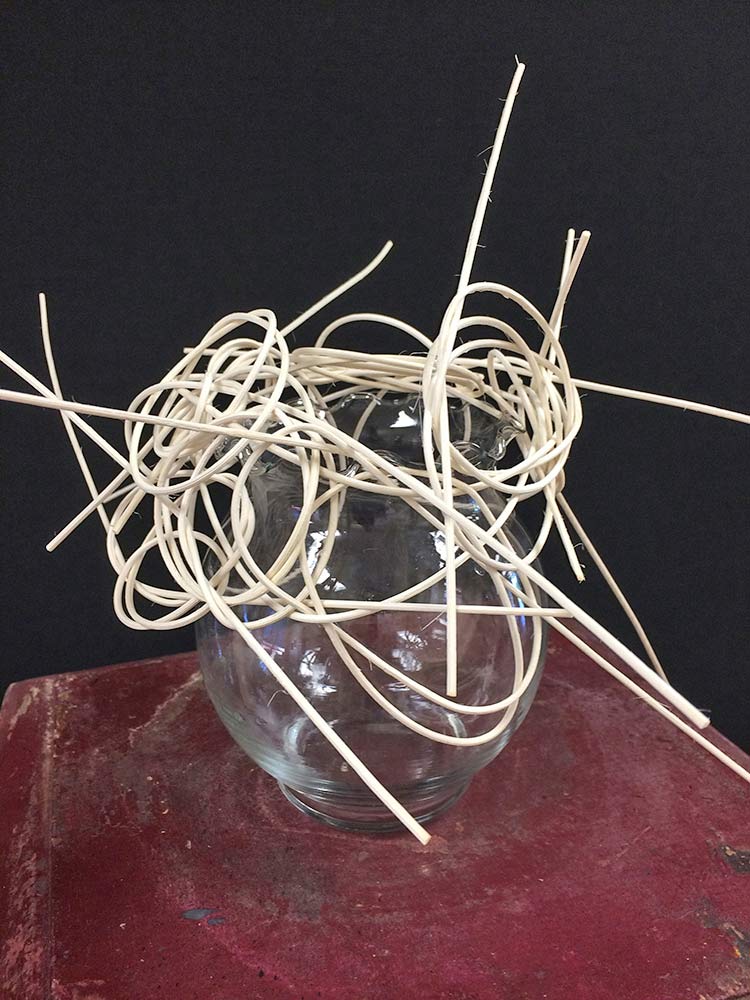
A wicker “flower frog” is good for holding zinnia stems in place.
Lengths of midollino (wicker) can be tied in open knots, then woven together with an additional length. This is called a “flower frog.” Place it on top of a globe-shaped vase and arrange flower stems in the vase. The wicker holder will stabilize zinnias or any type of small- to medium-sized flowers in the arrangement.
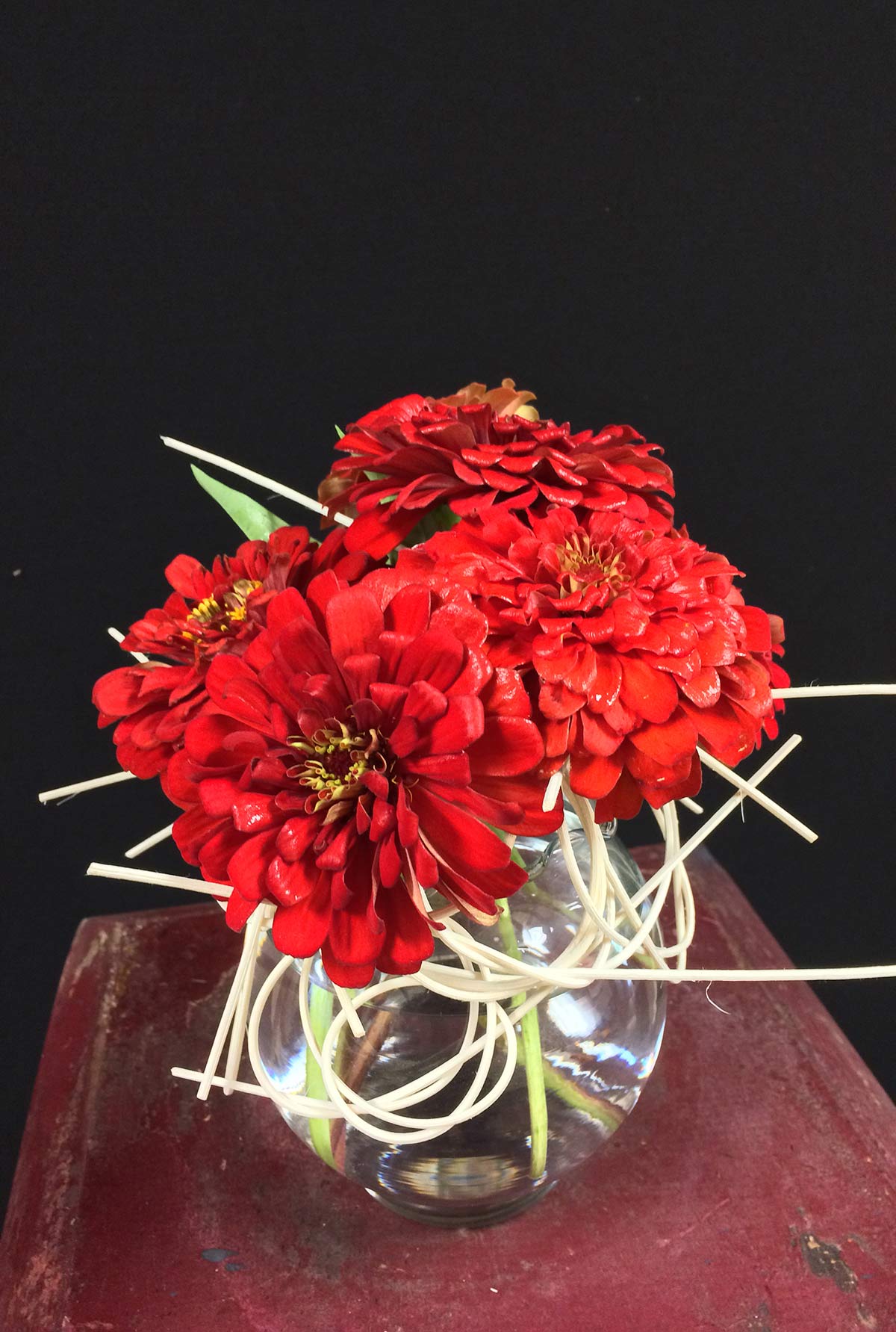
Tips to Lengthen the Display Time of Sunflowers and Zinnias
- Keep cut flowers out of direct sunlight and away from sources of heat. Heat energy speeds flowers through their lifespans. Cool spaces prolong lifespans.
- Rinse the stems. Field-grown flowers often have soil particles on their stems and leaves. This is especially true for sunflowers and zinnias because they have fine hairs on their stems and leaves. Lightly wash stems with water before using them in designs.
- Always keep flower stems in water. Make sure the stems are not too short to reach the water in the container.
- Use “fresh flower” foods. These solutions contain carbohydrates to encourage flower opening, along with citric acid and biocide to keep bacterial growth in check and extend the flower’s life.
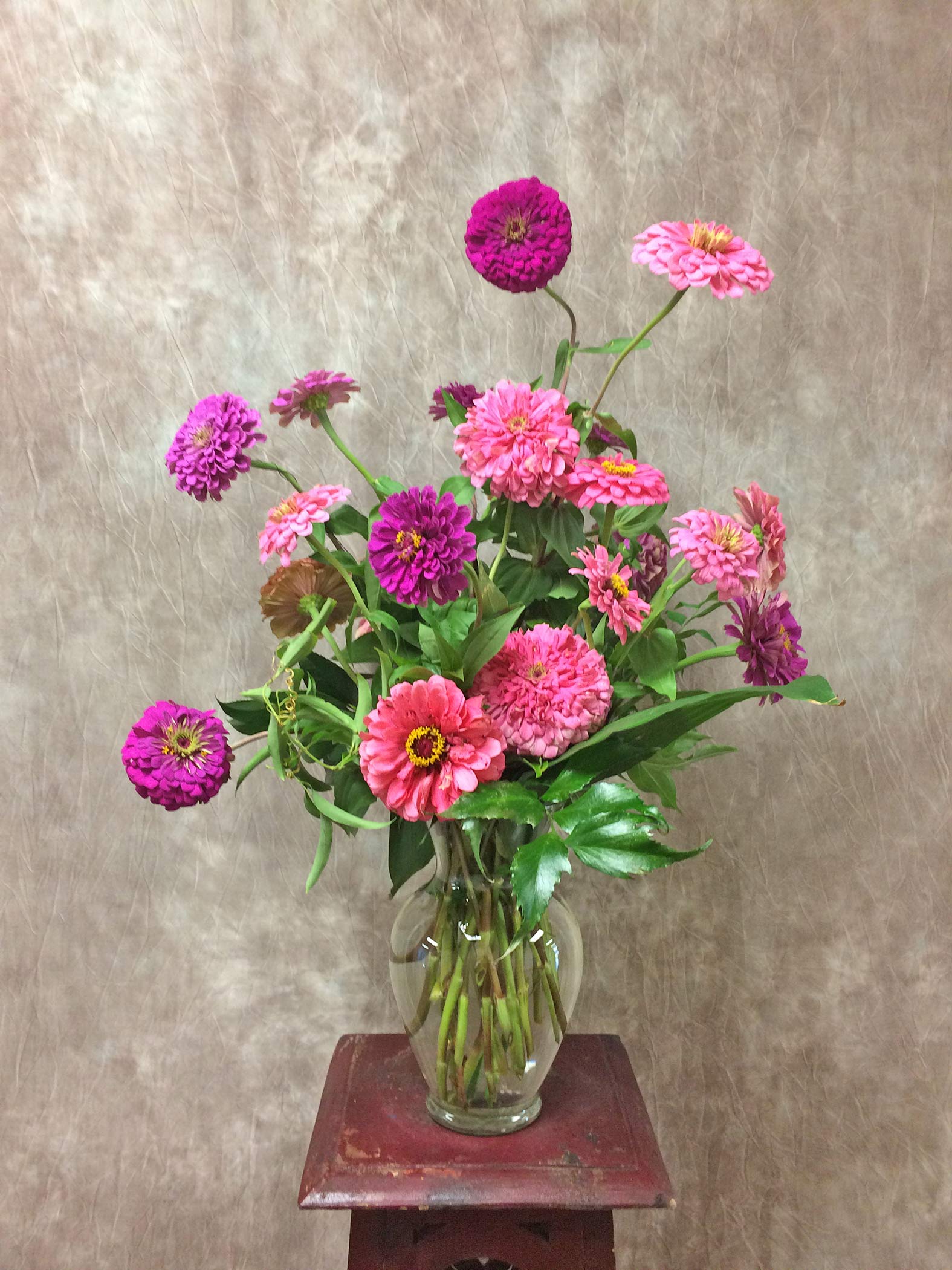
An analogous color combination of zinnias.
When creating an arrangement, it is important to keep the vase solution clear of organic debris to increase floral longevity. As stems enter the water, they introduce loose leaves as well as dirt and debris. This accumulation makes the vase water murky from the very start. To compound the problem, cut flower stems leak carbohydrates that can feed bacterial growth.
The best practice for a vase design is to make the arrangement in a work vase, then transfer it to a display vase. They can be identical or similar in size. Once the design is created, lift it from the work vase, taking care to remove any leaves or debris that would fall below the water line. Place the design immediately into the display vase that has been prepared with a fresh flower food solution. This practice keeps your flowers in the best quality water possible to ensure longevity.
The Right Tool for the Job
Floral knife
It is best to cut soft, herbaceous flower stems with a sharp knife. To learn the proper method, see MSU Extension Publication 3121 Using a Knife to Cut Fresh Flowers. Never use your floral knife to cut styrofoam or cardboard; this will quickly dull the blade.
Pruners
Pruners are good for cutting the woody stems of evergreens and for harvesting sunflowers and zinnias.
Multi-purpose shears and snips
Serrated blades cut though light-gauge wires. These are a good second choice for cutting fresh flower stems, but they do pinch water-conducting vessels. Snips are handy for cutting slender stems in the garden.

Floral knife (left) and pruning shears.

Snips (top) and multi-purpose shears (middle and bottom).
Master Floral DesignerTM
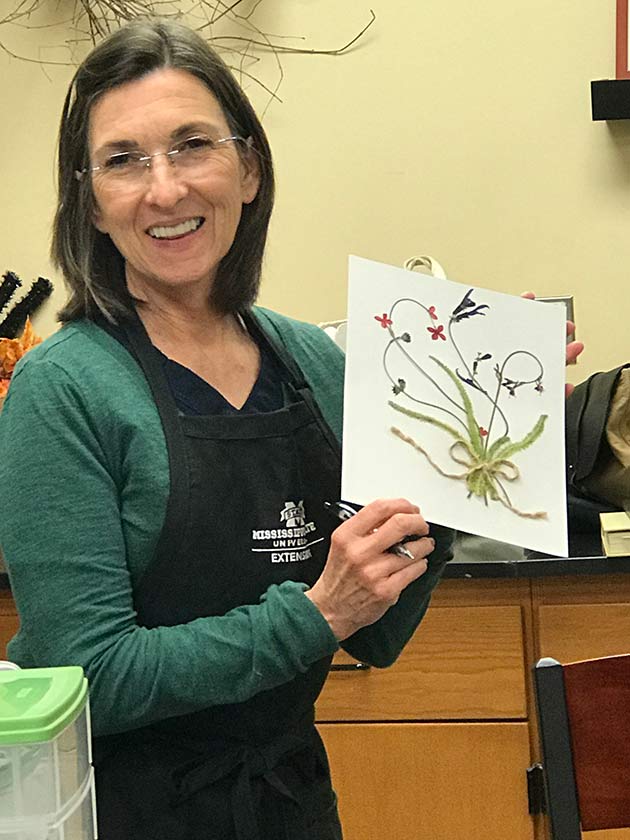
The Master Floral Designer program offers 42 hours of studio training in floral design. Our sessions include lively lectures on design principles, elements, and techniques, followed by demonstrations and hands-on creation of floral designs. Participants learn how to make a bow, corsage, and matching boutonnière; a European hand-tied bouquet; mass, line-mass, and line arrangements; and more. The studio segment culminates in the creation of an original floral design.
Participants who decide to pursue the full certificate and Master Floral Designer pin commit to 40 hours of volunteer service. Nonprofit promotion of floral design, such as creating church arrangements or fundraiser décor, teaching others about floral design, or helping with Extension floral programs, count toward this goal.

To learn more, visit coastal.msstate.edu.
Publication 3251 (07-24)
By James M. DelPrince, PhD, AIFD, PFCI, Associate Extension Professor, Coastal Research and Extension Center.
The Mississippi State University Extension Service is working to ensure all web content is accessible to all users. If you need assistance accessing any of our content, please email the webteam or call 662-325-2262.


